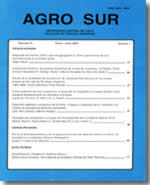Phenological and productive characterisation of Agrostis capillaris and Holcus lanatus in the Dominio Humedo of Chile
Main Article Content
Abstract
Agrostis capillaris and Holcus lanatus are very common species in the naturalised field in the Wet Dominion of Chile. In spite of this, these species have not been extensively studied. The objectives of this work were: to evaluate the phenological development, to establish the growing curves, to determine the occurrence dates of the different phenological stages, to establish the relationship between leave - stem and between lamina - sheath and also the different yield components of these species. An additional aim was to clarify the flowering and seed production periods.
The present study was carried out at the Vista Alegre Experimental Centre, Universidad Austral de Chile, Valdivia, Chile. Dactylis glomerata, was used as the control. Seed from the test species were collected from the naturalised field and sown in plots of 1.5 x 5.0 metres. Fertiliser was applied to allow them to show their maximum production. Comparisons were done between the species for the following variables: plant height, dry matter production, plant density, number of tillers per plant, phenological stage of the tillers, percentage of different yield components within the total yield production, lamina - sheath ratio, leave - stem ratio, density of inflorescence, number of seed per inflorescence, number of seeds per kilogram, weight of one thousand seeds, seed production per hectare and starting and ending dates of the different phenological stages. A complete randomised block design was applied. H. lanatus reached the greatest height (115 cm), density (4.200 tillers/m2) and yield (16.246 kg DM/ha). H. lanatus also had the highest ratio between lamina - sheath until October (more than 2.5). From November D. glomerata had the greatest lamina - sheath ratio, because most of the plants of A. capillaris and H. lanatus were flowering. From November, the leave - stem ratio was also higher for D. glomerata.
A. capillaris showed the highest number of inflorescences per hectare and the highest number of seeds per inflorescence. The maximum seed production per hectare was reached by H. lanatus with 1.306 kg. H. lanatus and A. capillaris showed a summer - autumn regrowth: 566 tillers/m2 by H. lanatus and 333 tillers/m2 by A. capillaris. Phenologically, H. lanatns was the first species that went into the reproductive stage, starting to elongate on November 16th it flowered from November 30th. On January 15th the seeds started ripening and on February 12th ripe seeds were present. A. capillaris started to elongate on November 30th and flowered from December 15th. The seed formation of this species started on January 3rd and ripe seeds were present from February 12th. D. glomerata was the latest of the species studied, starting to elongate on November 30th, the flowering and the seed ripening periods took place from January 3rd and ripe seed appeared on March 3rd.
It was concluded that Holcus lanatus and Agrostis capillaris have different phenological cycles, with each long phenological phases, demonstrating that the naturalised material present in the region has a high genetic diversity. Both species have the capability to produce high quantities of dry matter and seeds. Holcus lanatus and Agrostis capillaris are species that have an important place and function within the productive systems.

